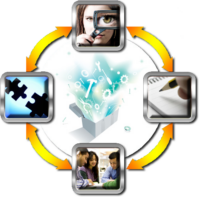 Solving “real world” problems provides students with an authentic and meaningful learning experience that promotes the development of skills necessary for success in the workplace and in life.
Solving “real world” problems provides students with an authentic and meaningful learning experience that promotes the development of skills necessary for success in the workplace and in life.
Problems that lend themselves to good PBL Challenges (case studies):
- are open-ended with several possible solutions
- stimulate the interest of students
- have “missing pieces” that challenge students and promote inquiry
- are interdisciplinary, requiring collaboration and teamwork
- have ideally been solved by the “experts” so that students can compare and contrast their solutions to the expert solution
In general, we have found it more difficult to turn troubleshooting problems into PBL Challenges because students need to have access to the details of a process – and that usually means too much information needs to be provided. Good problems also don’t have a solution immediately available through a Web search.
Here are a few examples of problems we have turned into PBL Challenges. To see all our Challenges, follow this link to the Challenge page.
- Choose a laser and design the delivery optics to strip 50 um copper wire (Photomachining)
- Design inexpensive, neighborhood friendly storm water remediation (TTF Watershed Partnership)
- Determine a process to laser weld two pieces of metal with an existing lower-power laser (IPG Photonics)
- Find a method to show that the light output of two light bulbs is equivalent (Cal Poly Pomona)
- Design an ergonomic lighting system for a submarine work station (RSL Fiber Systems)